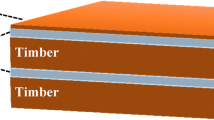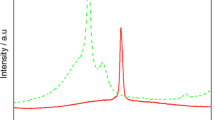Abstract
In this study, poly (ethylene-co-butyl acrylate, EBA-30) samples containing an intumescent formulation of ammonium polyphosphate and pentaerythritol and clays of different basal spacings had their flame retardant properties evaluated by thermogravimetric analysis, differential thermal analysis, and heating microscopy. Samples without polymeric matrix were also analyzed to observe possible interactions between the clays and the intumescent formulation. Thermal Analyses revealed that the basal spacings of the clays strongly influence their synergistic effect with the intumescent formulation studied.





Similar content being viewed by others
References
Jimenez M, Duquesne S, Bourbigot S. Characterization of the performance of an intumescent fire protective coating. Surf Coat Technol. 2006;201:979–87.
Le Bras M, Bourbigot S. Fire retarded intumescent thermoplastic formulations, synergy and synergistic agents: a review. In: Le Bras M, Camino G, et al., editors. Fire retardancy of polymers: the use of intumescence. London: The Royal Society of Chemistry; 1998. p. 64–75.
Demir H, Arkis E, Balköse D, Ülkü S. Synergistic effect of natural zeolites on flame retardant additives. Polym Degrad Stab. 2005;89:478–83.
Bourbigot S, Le Bras M, Bréant P, et al. Zeolites: new synergistic agents for intumescent fire retardant thermoplastic formulations: criteria for the choice of zeolite. Fire Mater. 1996;20:145–54.
Estevão LRM, Le Bras M, Delobel R, Nascimento RSV. Spent refinery catalyst as a synergistic agent in intumescent formulations: influence of the catalyst’s particle size and constituents. Polym Degrad Stab. 2005;88:444–55.
Ribeiro SPS, Estevão LRM, Nascimento RSV. Brazilian clays as synergistic agents in an ethylenic polymer matrix containing an intumescent formulation. J Therm Anal Calorim. 2007;87:661–5.
Ribeiro SPS, Estevão LRM, Pereira C, Rodrigues J, Nascimento RSV. Influence of clays on the flame retardancy and high temperature viscoelastic properties of polymeric intumescent formulations. Polym Degrad Stab. 2008;94:421–31.
Ribeiro SPS, Estevão LRM, Nascimento RSV. Effect of clays on the fire-retardant properties of a polyethylenic copolymer containing intumescent formulation. Sci Technol Adv Mater. 2008. doi:10.1088/1468-6996/9/2/024408.
Wang J, Liu Y, Xufu C. Effect of a novel charring agent on the thermal degradation and flame retardancy of acrylonitrile-butadiene-styrene. J Therm Anal Calorim. 2011. doi:10.1007/s10973-010-1011-6.
Gao M, Wu W, Yan Y. Thermal degradation and flame retardancy of epoxy resins containing intumescent flame retardant. J Therm Anal Calorim. 2009;95:605–8.
Chuanmei J, Chen X. Synergistic effects of zinc oxide with layered double hydroxides in EVA/LDH composites. J Therm Anal Calorim. 2009. doi:10.1007/s10973-009-0197-y.
Estevão LRM, Nascimento RSV. The use of heating microscopy in the study of intumescence in waste catalyst containing polymer systems. Polym Degrad Stab. 2002;75:517–33.
Marchal A, Delobel R, Le Bras M, et al. Effect of intumescence on polymer degradation. Polym Degrad Stab. 1994;44:263–72.
Boubirgot S, Le Bras M. Synergy in intumescence overview of: the use of zeolites. In: Le Bras M, Camino G, et al., editors. Fire retardancy of polymers: the use of intumescence. London: The Royal Society of Chemistry; 1998. p. 222–35.
Author information
Authors and Affiliations
Corresponding author
Rights and permissions
About this article
Cite this article
da Silva Ribeiro, S.P., de Moura Estevão, L.R., Novák, C. et al. Clays basal spacings effect on fire retardancy of polymers by TG/DTA. J Therm Anal Calorim 106, 535–539 (2011). https://doi.org/10.1007/s10973-011-1540-7
Published:
Issue Date:
DOI: https://doi.org/10.1007/s10973-011-1540-7




